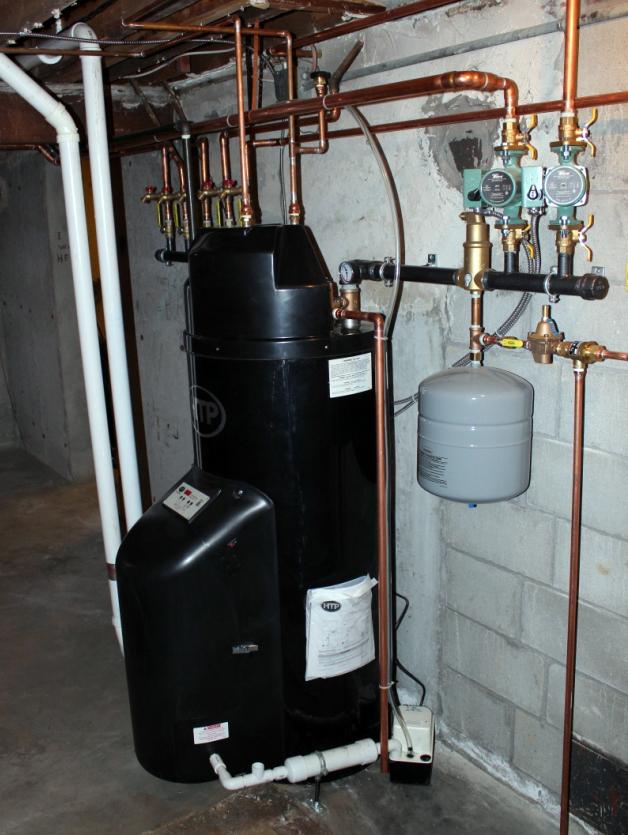So you currently have 168' of fin-tube for 120,000 BTU/hr of total boiler output, or ~715 BTU/ft-hr. (See
typical fin-tube output tables for reference.) The heat emission output from the fin-tube balances with at an average water temp (AWT) of ~200F, so even with the whole-house operating as a single zone the radiation is slightly undersized for the current boiler. The 28' zone is CRAZY undersized for the boiler, and it's burn cycles will be numerous & brief while serving that zone only, cutting into efficiency and putting wear & tear on the boiler.
If you dropped back to a direct-vented 3-plate cast iron 85% efficiency beastie like the
Burnham ESC3 with 60K of output you'd still be close to 2x oversized for the actual heat load, but at ~36o BTU/ft the whole-house radiation would balance with the boiler output at an AWT of about 140F which is fine. For just the single 28' zone calling for heat you're looking at about 60,000 BTU /28'= 2140 BTU/ft, which is still in crazy short-cycling territory. The 60' zone is at 1000 BTU/ft, which doesn't really balance, but it probably won't go nuts on short cycles when serving that zone only, since there is at least some thermal mass to the system. The 80' zone is at 750 BTU/ft, which would balance at ~2o5F AWT, which pretty much balances if you set the high-limit on the boiler to 220F.
There are some mid efficiency 2-plate atmospheric drafted boilers like the
Weil McLain CGa25 with 44K of output. The whole-house radiation would be 44,000/168'= 260 BTU/ft, which balances at an AWT of 130F. That could work, but you would need to be sure to install a bypass branch at the boiler to keep the water entering the boiler at 130F or higher to avoid damaging condensation on the boiler plates. You would also need a narrowing stainless liner to the flue to avoid destroying the chimney with condensation. It would balance at reasonable temps on the 60' & 80' zones, but at about 1600 BTU/ft it would still short-cycle on the basement zone, but not nearly as badly as the current boiler does.
If you stepped up the efficiency to a ~95% AFUE modulating condensing boiler, a 50K-in/47K-out unit like the
Peerless PF50 could work. (There are at least a half-dozen other similar sized pretty-good mod-cons in that range that could work). The min-fire output of that thing is about 15,000BTU/hr. One the 60' zone that's 250BTU/ft, which balances at an AWT of 125F, which means it will operate in the condensing temperature zone (= sub-125F return water entering the boiler) without short-cycling, as would the 80' zone. On the 28' zone you're still looking at 535BTU/ft, which would only balance at ~170F AWT, well above the condensing zone, but as long as it isn't short-cycling on all zones, that's probably going to be OK. If need be you may be able to fix short cycling on the basement zone with more radiation (another 30' of fin-tube is pretty cheap, if there's room for it) or by higher-mass radiation. The min-fire output of the thing is about your average winter load, so if you use the outdoor reset temperature controls (which raises & lowers the output temp of the boiler in response to the outdoor temp), once you tweak-in the temperature curves it would run in condensing mode almost all the time, and won't short-cycle (much).
Under outdoor reset you would max out the efficiency by dialing in the curve so that the burns are at a nearly 100% duty cycle whenever it's cold out, and dispense with thermostat setback strategies, since setbacks require higher water temps (= lower efficiency) for the recovery ramps. That would also almost guarantee that calls for heat from the basement zone would overlap calls from the other zones, limiting the amount of short-cycling you would see.
If going for a mod-con it's important to look at the min-fire output, since that determines the short-cycling potential. Anything with a min-fire input much higher than about 16,000 BTU/hr would not be appropriate for your radiation & loads, since it's output would be more than your average winter load, and it would put you in short-cycling territory on your smaller zone.
With any new boiler it's worthwhile considering adding an indirect-fired hot water tank as an other zone, since that increases the duty-cycle on the boiler (which increases it's AFUE), and when operated as the "priority zone", the water heater would have higher performance than most standalone tanks even with a tiny ~50K input/82% 2-plate cast iron boiler. The net hot water heating efficiency will be higher than any non-condensing tank water heater too.

